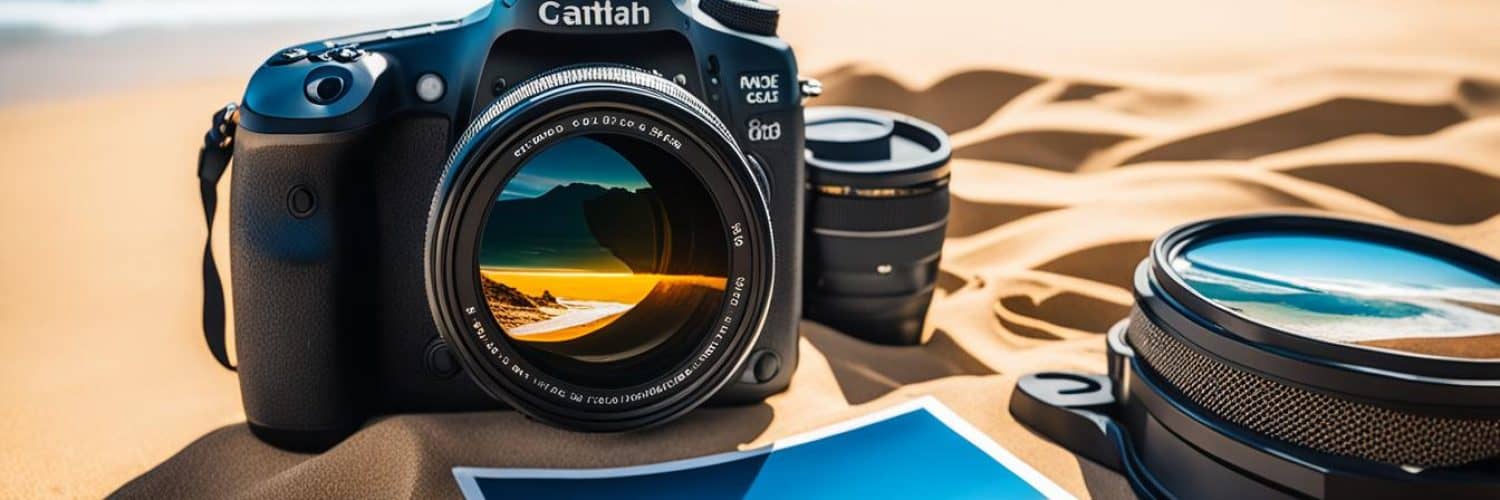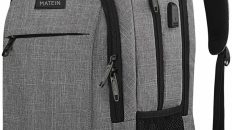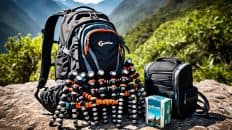Are you a travel enthusiast and a passionate photographer? If so, you know how important it is to capture stunning images of your adventures. To ensure the best image quality and protect your camera lenses, a UV filter is a must-have accessory for your travel gear.
UV filters not only enhance the clarity and vividness of your photos but also act as a barrier against dust, dirt, and scratches. They are specifically designed to reduce haze and eliminate the bluish cast caused by UV radiation, resulting in sharper and more vibrant images.
In this article, we have researched and curated a list of the top-rated travel UV filters available in the market. Whether you are capturing picturesque landscapes or bustling cityscapes, these filters will elevate your travel photography game to new heights.
Key Takeaways:
- UV filters enhance image quality and protect camera lenses during travel photography.
- They reduce haze and the bluish cast caused by UV radiation, resulting in clearer and more vibrant photos.
- UV filters act as a barrier against dust, dirt, and scratches, prolonging the lifespan of your lenses.
- Top-rated travel UV filters offer superior performance and compatibility with different camera lenses.
- Investing in a high-quality UV filter is essential for capturing the beauty of your travel destinations with precision and clarity.
Importance of UV Protection Lens Filters in Photography
UV protection lens filters play a critical role in the world of photography. These filters are not only essential for producing high-quality images but also for safeguarding camera lenses from potential damages. Let’s explore why UV filters are indispensable accessories for photographers:
- Improved Image Quality: UV filters reduce the presence of haze and the bluish cast caused by UV radiation, resulting in sharper and more vivid photos. By filtering out harmful UV rays, these filters enhance contrast and color saturation, ensuring optimum image clarity.
- Lens Protection: Camera lenses are susceptible to dust, dirt, scratches, and other hazards while capturing stunning shots. UV filters act as a first line of defense, shielding lenses from potential damages and preserving their longevity.
- Minimal Impact on Exposure: UV filters have minimal impact on exposure settings, allowing photographers to maintain their desired settings without compromising image quality. This makes them versatile and compatible with different camera lenses.
Whether you’re a professional photographer or an enthusiast, UV filters are particularly important in film photography, where the preservation of image quality is crucial. By using these filters, you can eliminate the bluish tint caused by UV radiation and capture images with exceptional clarity.
To visually illustrate the impact of UV filters on image quality, let’s examine the comparison below:
| Without UV Filter | With UV Filter |
|---|---|
As you can see, the image on the right, captured with a UV filter, showcases improved contrast, sharper details, and a natural color balance. This demonstrates the significant impact of UV filters on enhancing image quality.
The Science Behind UV Protection Lens Filters
UV radiation, a form of electromagnetic radiation, exists beyond the visible spectrum of light. It poses a threat to the quality of photographs, causing haze, bluish cast, and reduced contrast. To combat these issues, photographers use UV protection lens filters, which absorb or reflect UV light before it reaches the camera’s sensor or film.
By effectively reducing haze, eliminating the bluish cast, and enhancing contrast and color saturation, UV filters play a crucial role in improving image quality. These filters act as a barrier against the harmful effects of UV radiation, ensuring that photographers capture clear and vivid photos.
It is important to understand how UV filters work to appreciate their impact on photography. When UV light enters the camera through the lens, the filter’s specialized coating or material absorbs or reflects the UV rays. This process allows only the desired visible light to pass through, minimizing the negative effects of UV radiation on the final image.
Let’s take a closer look at how UV filters work using an illustrative example:
Imagine you’re photographing a stunning landscape on a sunny day. The UV filter, like a protective shield, intercepts the UV light rays emitted by the sun before they reach your camera’s sensor. By preventing these UV rays from affecting the image capture process, the UV filter eliminates the bluish cast caused by UV radiation and reduces the presence of haze. The result? A vibrant, clear, and captivating photograph that accurately represents the beauty of the landscape.
Here’s a visual representation of how UV filters work:
| Without UV Filter | With UV Filter |
|---|---|
The image on the left demonstrates the presence of UV radiation without a filter, showcasing a bluish cast and haziness. In contrast, the image on the right, taken with a UV filter, shows enhanced clarity, accurate colors, and improved contrast, thanks to the filter’s ability to block UV light.
Note that UV filters work best when used in combination with appropriate exposure settings and other lens filters for specific photography needs.
Now that we understand the science behind UV protection lens filters, let’s explore the various benefits they offer in the next section.
Benefits of Using UV Protection Lens Filters
Using UV protection lens filters provides numerous benefits for photographers. These filters not only enhance image quality but also offer an additional layer of protection for camera lenses, ensuring longevity and optimal performance. Let’s explore the advantages of incorporating UV filters into your photography arsenal.
Improved Image Quality
The use of UV filters enhances image quality by reducing haze and improving contrast and color saturation. By blocking out the harmful UV rays, these filters help capture sharper and clearer photographs, especially in outdoor and high-altitude environments.
Lens Protection
UV filters act as a shield for camera lenses, guarding against dust, dirt, and scratches. They minimize the risk of damage, preserving the integrity and optical performance of your lenses. Lens protection is particularly crucial for travel photographers who often encounter challenging conditions in various landscapes and climates.
Brand Consistency in Product Photography
For product photographers, maintaining brand consistency is essential to portray products accurately and build customer trust. UV filters eliminate the bluish cast caused by UV radiation, ensuring accurate color representation and fidelity. Consistent color rendering across product images also enhances the overall visual appeal of the brand’s offerings.
Prolonged Lens Lifespan
Investing in UV filters can significantly extend the lifespan of camera lenses. By acting as the first line of defense against potential damage, UV filters help prevent costly repairs and replacements. This cost-effective accessory becomes even more valuable when working in rugged or unpredictable shooting conditions.
Affordability and Versatility
UV filters are affordable and versatile, compatible with various camera systems and lens types. They are available in different sizes, making it easy to find the perfect fit for your lenses. Whether you shoot with a DSLR or a mirrorless camera, incorporating UV filters into your gear collection is a practical and budget-friendly choice.
To summarize, UV protection lens filters offer a range of benefits, including improved image quality, lens protection, brand consistency, prolonged lens lifespan, affordability, and versatility. By investing in these essential accessories, photographers can elevate their work and ensure the longevity of their equipment.
How UV Protection Lens Filters Improve Product Photography
When it comes to product photography, accurate representation of colors and contrast is crucial. UV protection lens filters play a significant role in achieving this by reducing haze and eliminating the bluish cast that can negatively impact the quality of your product photos.
By using UV filters, you can ensure that the colors in your product images are true to life, enhancing their visual appeal and boosting customer trust. The elimination of the bluish cast results in sharper and more vibrant photos that accurately showcase the products you are capturing.
Furthermore, UV filters provide an added layer of lens protection while shooting in various environments. They act as a shield, safeguarding your lenses from dust, dirt, and potential scratches, ensuring their longevity and optimal performance.
To illustrate the effectiveness of UV filters in improving product photography, take a look at the example below:
Image: Example of product photography utilizing a UV filter for enhanced color accuracy and contrast.
| Without UV Filter | With UV Filter |
|---|---|
| Noticeable bluish cast | True-to-life colors |
| Hazy appearance | Sharper and clearer details |
| Reduced contrast | Enhanced contrast for better visual impact |
As demonstrated in the example, the use of a UV filter significantly improves the overall quality of product photography. The colors are accurate, the details are sharp, and the contrast is enhanced, resulting in visually captivating images.
By incorporating UV filters into your product photography workflow, you can elevate your visuals, create a consistent brand identity, and build trust with your audience.
The History of the UV Filter
UV filters, also known as skylight filters, have a rich history in the world of photography. Initially, these filters were primarily used in film cameras to counter the blue cast caused by UV light, improving image quality. Additionally, UV filters provided an added layer of protection by safeguarding the lens’s front element from dust, dirt, and scratches.
With the advancement of digital cameras and sensor technology, debates emerged concerning the necessity of UV filters. The introduction of auto white balance in cameras raised questions about the practicality of using UV filters to correct color temperature. However, despite these advancements, many photographers continue to rely on UV filters for their lens protection capabilities.
“UV filters not only enhance image quality but also provide a physical barrier, shielding the lens from potential damages.”
The Importance of UV Filter: Lens Protection
UV filters are still widely used today because they offer critical lens protection. Even with advancements in camera technology, lenses remain susceptible to dust, dirt, and accidental scratches. By using a UV filter, photographers can ensure longevity and preserve the optical performance of their lenses.
Furthermore, UV filters are an excellent investment for outdoor photographers who often shoot in challenging environments. These filters act as a first line of defense, shielding the lens from potential damage caused by moisture, debris, and other environmental factors.
The Continuation of UV Filters in the Digital Era
Although the primary purpose of UV filters has evolved over time, they remain essential accessories for photographers. While sensors can handle UV light to a certain extent, using a UV filter can still enhance image quality by reducing haze and minimizing the bluish cast caused by UV radiation.
Moreover, the use of UV filters enables photographers to have consistent results across various lenses. By employing the same UV filter on multiple lenses, photographers can maintain color accuracy and avoid inconsistencies in post-processing.
Ultimately, the decision to use a UV filter comes down to personal preference and shooting conditions. While UV filters may not be mandatory for all situations, they undoubtedly provide valuable lens protection and can enhance image quality in certain scenarios.
Pros and Cons of UV Filters
| Pros | Cons |
|---|---|
| Enhances image quality by reducing haze and bluish cast | May cause minor loss of image sharpness |
| Protects the lens from dust, dirt, and scratches | Can introduce lens flare in certain shooting conditions |
| Preserves lens resale value by maintaining its physical condition | Requires additional care and maintenance |
| Acts as a barrier against moisture, debris, and other environmental factors | May lead to increased lens glare in specific situations |
As with any photographic accessory, it is essential to weigh the benefits and drawbacks of using a UV filter based on individual shooting preferences and needs.
Filters Can be Faulty
Although UV filters are generally reliable accessories for photographers, it is important to be aware that there have been instances where faulty filters have caused artifacts or distortions in images. These faults can present themselves as concentric rings, lines in bokeh, or unusual patterns, compromising the overall quality of the photograph.
Investing in high-quality UV filters from reputable brands is crucial to ensure optimal image quality and avoid potential issues. When selecting a UV filter, consider factors such as the reputation of the manufacturer, the build quality of the filter, and the materials used.
“Investing in high-quality UV filters helps prevent artifacts or distortions in images and ensures optimal image quality.”
By choosing a reliable and reputable filter, photographers can minimize the risk of encountering faulty UV filters and achieve superior image quality.
Do Lens Hoods Offer Better Protection?
When it comes to protecting your camera lens, lens hoods are often suggested as an alternative to UV filters. These hoods are designed to prevent oblique light from causing flare, and they offer some protection against impact, rain, and accidental contact. However, it’s important to note that lens hoods do not provide the same level of protection as UV filters.
Lens hoods can be beneficial in certain situations, such as outdoor photography where the sun is directly in front of the lens. They help to reduce lens flare and improve image quality in these conditions. Additionally, lens hoods can offer physical protection to the front element of the lens, guarding against accidental bumps or scratches.
However, it’s essential to understand that lens hoods cannot shield the lens from other potential damages. For instance, they do not offer any protection against dust or dirt particles that may settle on the lens surface. Lens hoods also cannot provide the same level of shielding as UV filters against certain types of damage.
In situations where you want comprehensive lens protection, it is common for photographers to use both lens hoods and UV filters. By combining these accessories, you can enjoy the benefits of reduced lens flare and improved image quality, as well as protection against dust, dirt, and various forms of damage.
Pros and Cons of Lens Hoods vs. UV Filters
| Pros of Lens Hoods | Cons of Lens Hoods |
|---|---|
| Reduces lens flare | No protection against dust and dirt |
| Provides physical protection | Does not shield against certain types of damage |
| Improves image quality in certain conditions |
In summary, while lens hoods offer benefits such as reduced lens flare and physical protection, they do not provide the same level of protection as UV filters. Photographers often use both lens hoods and UV filters to ensure comprehensive lens protection and maximize image quality.
Best UV Filters for Lens Protection
When it comes to protecting your camera lens, investing in a high-quality UV filter is essential. Not only do these filters provide superior lens protection, but they also eliminate the bluish cast caused by UV radiation and repel dust and water, ensuring clear and crisp images.
In this section, we will explore some of the best UV filters available in the market that offer top-notch lens protection and enhance the image quality. Let’s take a look at our top-rated picks:
- Breakthrough Photography X4 UV Filter
- B+W XS-Pro Clear UV Haze Filter
- Tiffen UV Protection Filter
- Hoya PRO1 Digital UV Multi-Coated Glass Filter
- AmazonBasics UV Protection Camera Lens Filter
Each of these filters is known for its exceptional performance and durability. Take a closer look at their features and benefits:
| Filter Brand | Features |
|---|---|
| Breakthrough Photography X4 UV Filter | High-quality glass Multi-resistant coating for repelling water and dust Slim design to prevent vignetting Zero color cast |
| B+W XS-Pro Clear UV Haze Filter | Brass mount for durability Extra-thin design to eliminate vignetting High-quality Schott glass |
| Tiffen UV Protection Filter | Multiple layers of coating to reduce flare and ghosting Protection against dust, dirt, and scratches Available in different sizes |
| Hoya PRO1 Digital UV Multi-Coated Glass Filter | Digital multi-coating to minimize flare and ghosting Hardened glass for durability Compatible with wide-angle lenses |
| AmazonBasics UV Protection Camera Lens Filter | Multiple coating to reduce lens flare Protective case included Compatible with various lens sizes |
With these top-rated options, you can confidently protect your camera lens while ensuring superior image quality. Choose the UV filter that best suits your needs and embark on your photography adventures with peace of mind.
Now, let’s move on to the next section, where we will discuss how to choose the right UV filter for your camera.
Choosing the Right UV Filter for Your Camera
When it comes to selecting a UV filter for your camera, there are a few important factors to consider. The size and quality of the filter play a crucial role in achieving optimal results. To ensure compatibility, choose a filter that matches the diameter of your lens. This will guarantee a proper fit and prevent any unwanted vignetting or obstruction.
Equally important is the quality of the UV filter. Investing in a high-quality filter made with premium glass and advanced coatings is key to minimizing image distortion and maximizing protection. These filters are designed to deliver exceptional optical performance, ensuring clear and sharp images with no added artifacts.
It’s always recommended to opt for top-rated brands known for their optical quality and durability. These brands have a reputation for producing reliable and well-crafted filters that meet the needs of professional photographers. By choosing a trusted brand, you can have confidence in the performance and longevity of your UV filter.
“Selecting the right UV filter is crucial to maintaining the integrity of your images. Investing in a high-quality filter ensures optimal protection for your lens and enhances image quality.” – Professional Photographer
Maintaining and Using UV Protection Lens Filters
Proper maintenance and usage of UV protection lens filters are essential for optimal results. By following these guidelines, you can ensure that your filters are in top condition and that you are using them correctly to capture stunning photographs.
Regular Cleaning
To maintain the effectiveness of your UV filter, it is crucial to clean it regularly. Use a microfiber cloth or a lens cleaning solution specifically designed for camera lenses to remove any dust, smudges, or fingerprints. Gently wipe the surface of the filter in a circular motion until it is clean and clear.
Storage
When your UV filter is not in use, it’s important to store it properly to avoid any damage. Keep the filter in a protective case or pouch that provides cushioning and prevents any potential scratches or impacts. A dedicated filter pouch or a section in your camera bag specifically designed for filters is an excellent way to keep them safe and secure.
Secure Attachment
When attaching the UV filter to your lens, make sure it is securely fastened. However, avoid overtightening, as this can cause damage to the filter or your lens. Tighten the filter until you feel resistance, ensuring a snug fit. Always refer to the manufacturer’s instructions for attaching and removing the filter to prevent any mishaps.
Quick Replacement Techniques
Knowing and practicing quick techniques for removing and replacing the UV filter is essential to avoid missing photo opportunities. Familiarize yourself with methods such as using lens filter wrenches or a gentle twist-and-slide motion to quickly switch filters as needed. This will help you capture precious moments without wasting time.
Remember, proper maintenance and using UV protection lens filters correctly will ensure that you capture stunning photographs while keeping your lenses protected. By incorporating these practices into your photography routine, you can enjoy the benefits of enhanced image quality and prolonged lens lifespan.
| UV Filter Maintenance Tips |
|---|
| Regularly clean the filter with a microfiber cloth or lens cleaning solution. |
| Store the filter in a protective case or pouch to prevent damage. |
| Attach the filter securely to your lens without overtightening. |
| Learn quick techniques for removing and replacing the filter to avoid missing photo opportunities. |
Conclusion
In the world of travel photography, having the best tools is essential for capturing breathtaking moments. Among these tools, a reliable travel UV filter for lenses is a must-have. Not only does it enhance image quality, but it also provides the much-needed protection for your camera lens.
When you’re out exploring different landscapes and encountering diverse lighting conditions, a travel UV filter acts as a dependable shield, reducing haze and mitigating the bluish cast caused by UV radiation. This allows you to produce clear, vivid imagery that truly reflects the beauty of your surroundings.
By carefully selecting the best travel camera lens UV filter and understanding its benefits and usage, you can elevate your photography game. Whether you’re a professional or an enthusiastic hobbyist, investing in a high-quality UV filter ensures that your images maintain optimal contrast and color saturation, all while safeguarding your valuable lenses from dust, dirt, and scratches.
So, before you embark on your next adventure, remember to equip yourself with the best travel UV filter for lenses. It’s not only a valuable tool for enhancing your travel photography, but also a protective companion that will enhance the longevity of your lenses. With the right travel UV filter, you can capture stunning images that truly do justice to your travel experiences.
FAQ
What is the purpose of a UV filter for lenses?
A UV filter serves two main purposes – it improves image quality by reducing haze and the bluish cast caused by UV radiation, and it acts as a protective barrier for camera lenses, shielding them from dust, dirt, scratches, and other potential damages.
How do UV protection lens filters work?
UV filters work by absorbing or reflecting UV light before it reaches the camera’s sensor or film. This reduces haze, eliminates the bluish cast, and enhances contrast and color saturation, resulting in improved image quality for your photographs.
What are the benefits of using UV protection lens filters?
UV filters offer several benefits, including improved image quality, enhanced contrast and color saturation, and protection for camera lenses against dust, dirt, and scratches. They also help maintain brand consistency in product photography and can prolong the lifespan of lenses.
Can UV filters improve product photography?
Yes, UV filters can improve product photography by reducing haze and eliminating the bluish cast that can affect color accuracy and contrast. By ensuring accurate colors and contrast, UV filters help create clear and vibrant product images, building trust with customers and maintaining brand consistency.
Are UV filters still necessary in the digital age?
While debates exist regarding the necessity of UV filters due to advancements in sensor technology and auto white balance, many photographers still use UV filters for lens protection. They provide an additional layer of safeguarding for camera lenses, which can be crucial in various shooting environments.
What should I look for when choosing a UV filter?
When selecting a UV filter for your camera, consider factors such as filter size, quality, and compatibility with your lens. Opt for high-quality filters made with premium glass and advanced coatings to minimize image distortion and maximize lens protection. Investing in top-rated brands known for their optical quality and durability is recommended.
How do I maintain and use UV protection lens filters effectively?
To maintain optimal results, regularly clean the filter to remove dust and smudges, and store it in a protective case when not in use. When attaching the filter to your lens, ensure a secure fit without overtightening that could cause damage. Learn techniques for quickly removing and replacing the filter to avoid missing photo opportunities.







Add comment